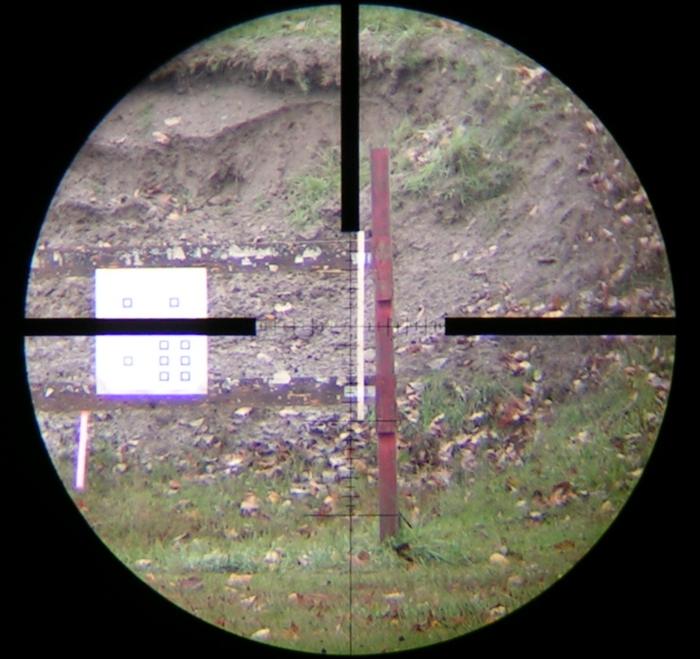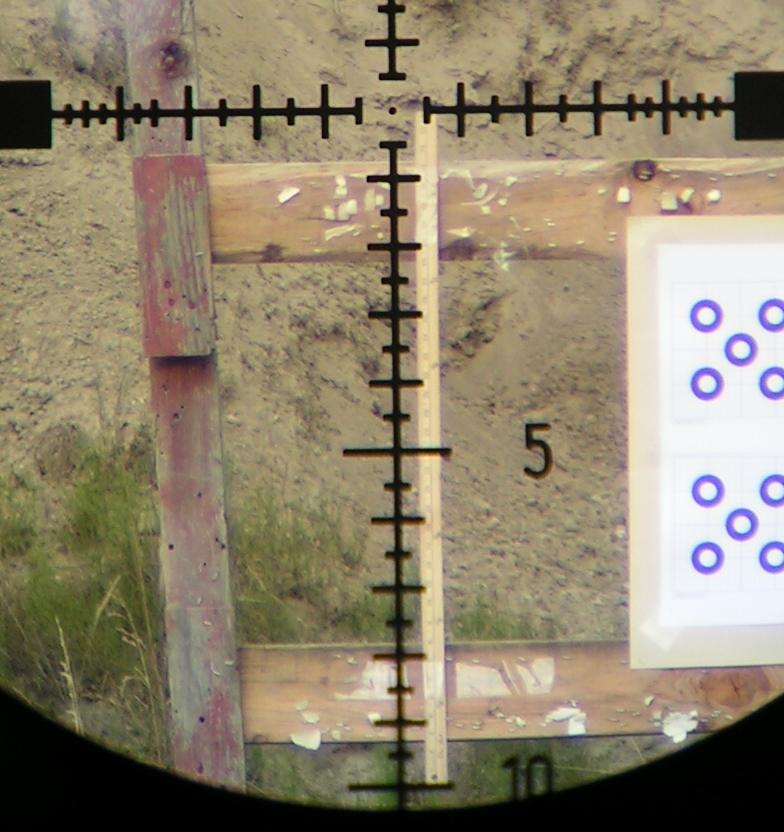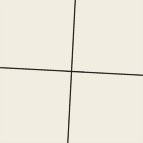I had been meaning to add this here. Largely cut and past but should be helpful to many:
For others asking, I'll try and give a little primer.
First of all, check out Lindy's
How to Optically Check a Rifle Scope for some excellent information some of which I'll duplicate below.
It's not rocket science guys, you don't need to be an Engineer or even be particularly smart. You just need to be smart enough to realize it's an important thing to do if you shoot long range much.
About the easiest method in "the real world" is with a yardstick because everybody has one and they work out nicely being exactly 10 Mils at 100 yds:
Naturally it's easier to be more accurate with a higher powered scope:
Easy way to verify the calibration of your reticle. 10 mils, 36". Bam, done.
Next you want to verify click value and/or reticle perpendicularity with respect to the turret movement. For this you need to hold the rifle very steady. It's very difficult to do by yourself by hand; if you do it a bunch of times and sort of take an average you can get an idea if there's a big error but you won't be exact. Having buddies hold the rifle and click the scope while you look increases accuracy somewhat. But by far the best is having a gunsmith vice of some type so you can solidly lock down the rifle.
I've seen people mention using calibrated paper. That's fine too as long as it's big enough (measuring 10" or so at 100 yds just isn't enough accuracy; I feel 10 mils or more is the minimum), it's far enough (the closer the paper or object is the smaller the errors will be that you're trying to measure) and it needs to be far enough you can eliminate parallax
completely.
You don't even need any measuring device to get some good data. With a good tactical reticle, you can get a relative measurement between the reticle and the turrets by pointing at anything. Typical Mil reticles are very easy as the top and bottom posts are usually 10 Mils apart. Simply line the top of the bottom post on an aiming point in the distance exactly and crank in 10 mils. If the top post's edge is now exactly where the bottom post's edge was, your reticle matches your clicks.
Relatively speaking they're dead on with one another. You should still check them with a yardstick, barber pole, etc, to make sure they're absolutely correct, but in my experience reticles are more consistent than click values so your odds look good.
The same goes for reticle cant with respect to the turrets. All you need is a straight edge at which to aim. It can be a yardstick, post, corner of a building, etc. But it needs to be perfectly straight.
Lock down the rifle with the reticle on the edge--exactly lined up on the edge and crank in 10 mils or so. If the reticle stays on the edge, you're good. If it moves laterally with your vertical turret input, you have a reticle that's not square with the turrets. Clicking windage to see how many clicks it takes to put the reticle back on the edge will allow you to calculate the angle.
Another tool one can use to check these things is a collimator. Some quality boresighters with a good grid qualify so we aren't talking about some super expensive lab equipment here. If you do things correctly, you will get exactly the same answers using one of these and doing stuff "in the real world." I've done it enough times both ways to feel very confident accurate results can be had using one of these--actually I feel this method provides better accuracy since rifle movement is taken out of the equation, mirage is taken out of the equation, parallax is taken out of the equation, etc.
Here's a visual on how that works:
First, line stuff up and check the reticle against the grid. This grid is in IPHY. As you can see, the 2 mil mark above the horizontal stadia and the 8 mil mark show 10 mils equal 36" on the grid--within a fraction of a line width or so which I figure is "close enough."
Then you line stuff up; I used a line to the right of the main one as it made the pics look less cluttered. For checking reticle cant you must line up the vertical line with the reticle as well as humanly possible.
Crank in 10 Mils. Here are your results. As you can see with this scope, the first thing you've noticed is the reticle is no longer on the line. It has not just shifted a tiny fraction laterally but you can actually see daylight between the line and reticle. This shows the reticle cant with respect to the turrets (the tool and the reticle are lined up making the turrets canted with respect to them).
Measure it numerous times, line the thing up over and over and you get an average of roughly 1.5-2 clicks required to put it back on the line. That translates into a degree or a bit more. Just enough I can't say "good enough."
Next notice the reticle has moved a bit more than 37" where it should have only moved 36". We checked the grid against the reticle so even if the grid was off, that would mean the reticle was also off as the reticle and the turrets don't agree. Either way, you have a problem.
Now while you don't need to calibrate a yardstick, you should calibrate (or at least check the calibration of) your grid in the collimator. The easiest way of doing this is checking it against scopes with known good reticles--that you've carefully checked in the real world and verified. I've done that with this one with numerous high end scopes (including the IORs pictured above but didn't happen to take a pic of them) so I know it's within a fraction of 1% true.
But for peace of mind it's always good to have a control, a standard, a sanity check. For this I threw on a Premier 3-15X50:
10 Mils on the reticle measures 36" within a fraction of a line width ("good enough").
Line things up the same way.
Crank in 10 mils. As you can see, the reticle is still on the line. It may have shifted a small fraction of the line's width amounting to a small fraction of 1 degree, but it's such a tiny amount likely challenging my ability to line them up correctly--definitely falling in the "good enough" category.
Also notice it moved 36", within a fraction of a line width. Notice the 10 Mil mark on the upper vertical stadia is exactly on the zero line indicating the reticle and turrets match exactly.
In other words, it passes as the deviations are so tiny the accuracy of the tool and my methods may be responsible for some or all of the deviations.
Hopefully if anything good comes of this thread it'll be people get educated a bit and measure their optics. I didn't start doing this when I bought the PST and it certainly isn't the first scope to have less than perfect results. The nasty truth is most people who are thinking their scopes are perfect only think that because they have not measured them.
People mention lack of QC.... I'll remind them once again Leupold says +/- 3 full degrees of reticle cant is within spec and will pass the best QC in the world because it's within spec! I measured this one at only around 1 degree.
There are manufacturers selling scopes a shitload more expensive than this one where +/- 2% is within spec for click value. This scope is just a hair outside that mark.
Most people would never notice these deviations. Many people would notice similar deviations on their own favorite scopes of whatever brand if they actually measured them.
So again I'll ask people keep the proper perspective. I get paid to be anal. I make my living worrying about tiny little numbers. It's hard for me to do things any other way--especially when I enjoy being able to make first round hits at crazy ranges with new equipment and new loads, etc.
When you worry about the little things, the big things take care of themselves. So you don't have to blame being way off on the first round on "ballistic programs aren't accurate, they just give you a rough idea," or "the BC of this bullet out of
my rifle is really 1.5!!!" or "it must be a bunch of spin drift...yeah, that's it!" etc.
CSTactical said:
But let's say the reticle is SO canted it looks like an X as long as you use the turrets that are level the reticle will move on the X & Y access of the turrets and the impact of the round will be in the center of the reticle. You will not have to use the wind-age knob to correct for an error.
While that is technically correct, I don't agree it's a desirable condition. To me, a fundamental part of marksmenship is trying not to cant the rifle--especially when shooting at long range. The reticle is your first tool with which to do so. Yes, there are environments where this is difficult and one should resort to referring to an external bubble level of some sort.
But it's not difficult in many environments. From targets to target frames to window frames to door frames to buildings to pine trees to animals the world is full of vertical references. Having to hold your scope crooked with the world in order to make it track correctly is not the optimum setup in my opinion.
I do realize at least one manufacturer says reticles canted up to 3 degrees are just fine. I disagree. Here is a reticle canted 3 degrees with the world:
(Props to jonMT for that)
If people don't mind holding their scope that crooked and using an external bubble level in situations where it shouldn't be needed in order to get the scope to operate correctly, it's their money. That's fine with me.
However, I will choose to spend my money on scopes with straight reticles.
Again, this scope wasn't nearly that bad as I stated above at only around 1 degree--it was just barely out enough to bother me. If that isn't enough to bother some people, that's fine. People were wanting to know the accuracy of the adjustments so that's what I reported.
I know you always want a scope to be spot on but to be honest I do not feel 3% is that big of a deal.
You're right, it's really not. For Ballistic Geeks like me I can compensate pretty easily. The thing is as this thread demonstrates very few people measure their clicks. If it says .1 Mil they expect it to be and so when they can't make first round hits even after doing everything else correctly because of an error in the scope, that makes the scope a poorer tool than a scope that is dead on.
And while there is much software out there now that allows you to compensate, this was not always the case. Some of the most popular software for a very long time was unable to compensate for out of spec clicks.
And when you're swapping a Mil scope for another Mil scope on a rifle having to use different dope for the same rifle, same load, etc, is rather annoying.
So while I agree more sophisticated users can compensate, that doesn't make it right. When $400 scopes can have accurate clicks, in my opinion there really isn't an excuse for more expensive tactical scopes to be very far out of spec.
Again, some manufacturers may disagree, but Vortex isn't one of them. They agree the scopes should be in spec and are working hard to make sure that they will be.
ReaperDriver said:
Dumb question: does using a collimator replace the need for a box test? Someone mentioned that box tests are potentially flawed due to innaccuracy of the rifle and shooter. So if I do this grid test, do I still need to do a box test?
You always need to do actual firing to be sure of a scope. One of the scope's job is to keep the reticle where it is supposed to be during recoil which it doesn't have to do on the collimator.
However, you can get much of the same information you'd want to get from a box test with the collimator, and arguably more accurately (it eliminates the shooter changing hold, canting the rifle, the rifle's accuracy, wind, mirage, and all sorts of other things that can interfere with a live test) so it's the first thing I do with a scope. One thing is for certain, if the scope isn't tracking correctly on the collimator, hoping it will in real life is a way to waste ammo and nothing more.
Unfortunately, most of the box tests I see done (especially on hunting boards) aren't good enough to tell much about a scope other than a complete failure in tracking. They're done over too small a distance, the group sizes are too large and often if the group is even remotely in the right vicinity they're declared a success.
If a scope tracks perfectly on the collimator that does answer most of the questions people shoot box tests to answer, so in a sense the answer is a qualified yes. I do let the collimator testing answer those questions (click value, reticle straightness, looking for erratic reticle movement or sticking, etc).
But of course, real shooting needs to be done. If recoil is causing erratic reticle movement, that'll usually show up in group sizes as well. And while I don't do specific box tests much, I do make a point of dialing way up for a far target, down to a close target, back up to a far target, etc, so much that any problems with elevation tracking will show up quickly.
But yeah, if you measure meticulously on a collimator, the rifle shoots tiny groups with the scope, it's really unlikely you're going to have any surprises tracking-wise unless you actually break something.



